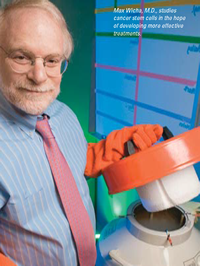Targeting the Source
Cancer Stem Cell Research Offers Hope for Cure

Despite billions of dollars spent on research, cancer remains the no. 2 cause of death in the United States.
Today's doctors have better ways to find and treat early stages of the disease. But once cancer spreads, current treatments too often don't work. Why haven't we cured cancer yet?
We talked to Max Wicha, M.D, founding director of the Rogel Cancer Center and distinguished Professor of Oncology, about research on cancer stem cells. Many scientists now believe cancer begins when these stem cells divide abnormally and grow out of control. Rogel Cancer Center scientists are developing new treatments to target these stem cells. Wicha believes this research will revolutionize the way physicians treat cancer.
What are cancer stem cells?
Most cells in the body live for a short time, so we need a regular supply of new cells to replace old ones. These new cells come from the division of what scientists call "adult" stem cells, which are found in every organ in the body. Breast stem cells make new cells in breast tissue, for example. Liver stem cells make new liver cells.
Cancer stem cells are adult stem cells found in different types of cancer. When cancer stem cells divide, they make more cancer cells. They divide abnormally and too often. We believe this uncontrolled division of cancer stem cells is responsible for the development, growth and spread of cancer.
How common are cancer stem cells?
On average, only about 1 percent of the millions of cells in a cancer are true cancer stem cells. But we believe they exist in all types of cancer. They were first discovered in 1994 in leukemia. In 2003, U-M Rogel Cancer Center scientists were the first to find them in breast cancer tumors.
Why are these cells so important?
Cancer stem cells are responsible for the development, growth and spread of cancer. If we had a way to destroy or control these stem cells, we could cure cancer. Unfortunately, traditional therapies like chemotherapy don't work. They kill most cells in the tumor, but not stem cells. So, the cancer often returns. We want to develop new treatments targeted at cancer stem cells, because if these cells are eliminated, the cancer won’t grow and spread to other parts of the body.
Will cancer stem cell research change how doctors treat cancer?
This research could change everything. Analyzing the stem cells in a patient's tumor will help us predict how aggressive the cancer will be and determine the best treatment plan for each patient. Most importantly, killing cancer stem cells could stop the disease from coming back. It's our best hope for a real cure. Also, new therapies that target and kill stem cells could eliminate side effects.
How much U-M Rogel Cancer Center research involves cancer stem cells?
Our goal is to become the world's leader in research on cancer stem cells and in the development of new cancer therapies, so we have committed significant resources to this research. We have teams of scientists studying stem cells in most types of common cancers, including leukemia, melanoma, myeloma, adrenal, breast, colon, head and neck, lung, pancreatic, prostate and thyroid cancers.
I am pleased to report that we also have support from federal funding agencies and private donors, including a recent gift from the Taubman Medical Research Institute.
When will stem cell-based treatments beready for use in patients?
Before they are approved, new treatments must be tested to prove they are safe and effective. This process takes several years. Currently, cancer center researchers are conducting a small study in patients of a treatment aimed at stem cells in multiple myeloma. Next year, we hope to begin the first human trials of a treatment targeted at breast cancer stem cells. We aren’t recruiting for these studies now, because they involve just a few patients with advanced cancer that has not responded to traditional therapy. But within the next few years, we hope to begin larger clinical trials of stem cell-based treatments for several types of cancer.
Continue reading the Winter, 2008 issue of Thrive
